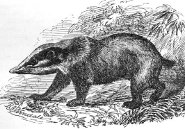 The hog badger (Arctonyx collaris) is the world’s largest badger, which is still smaller than a German shepherd. It only weighs 15 to 31 pounds (7 to 14 kg.) But this is a fierce creature one should stay away from – even other hog badgers. Unless it is time for mating in the late spring and early summer, hog badgers will attack each other. Hog badgers possess formidable teeth and emit a powerful stench when angered or frightened. This stench comes from two glands on either side of its anus.
The hog badger (Arctonyx collaris) is the world’s largest badger, which is still smaller than a German shepherd. It only weighs 15 to 31 pounds (7 to 14 kg.) But this is a fierce creature one should stay away from – even other hog badgers. Unless it is time for mating in the late spring and early summer, hog badgers will attack each other. Hog badgers possess formidable teeth and emit a powerful stench when angered or frightened. This stench comes from two glands on either side of its anus.Once found in forests all throughout Southeast Asia, they are now only found in Northeastern India, Myanmar, Vietnam, Southern China, Thailand, Lao People’s Democratic Republic (Laos) and Cambodia. Although tigers, leopards, humans and their hunting dogs are the only known predators of hog badgers, they are classified as Near Threatened by the International Union for the Conservation of Nature. As their habitat is destroyed, so are the hog badgers.
Physical Description
The hog badger gets its name from its pig-like pink snout. Otherwise, the body is built and colored like the more familiar European badger (Meles meles.
The hog badger has a long, white striped dark head that seems small in relation to body size. Their body fur are various shades of dark brown tipped in black, but their tails are mostly white, possibly to advertise that they can emit a skunk-like odor. Males are larger than females. Male body length, including the tail can reach 26.38 inches (67 cm), while females are only 17.7 inches (45 cm.)
Behavior
Not much is known about the natural behavior of wild hog badgers. They live mostly underground and are nocturnal. They create burrows and tunnels underground with their powerful claws and snout but sometimes come up for hunting insects and small mammals like mice. They also mark territory with their urine and musk glands on conspicuous grasses, tree trunks and rocks. They also eat fruits, tubers and plant roots. Their favorite food is an earthworm. Wild hog badgers are thought to hibernate from November until early March, but rarely do so in captivity.
After mating, female hog badgers always produce offspring in early March or late February. In captivity, the gestation is always six to eight weeks, no matter when the hog badgers bred. This suggests that in the wild, females can delay their pregnancies so that their young are always born in the early spring, when food is available. This strategy also occurs in weasels, ferrets and the European badger. Females produce two to four cubs per litter. Hog badgers mature rapidly and reach adult size between seven and eight months of age. It is unknown how long hog badgers live in the wild, but in captivity they can reach 14 years of age, with luck.
Keywords: brown , white , black , stripe , pink , claw , tail , nocturnal
The Hog badger is listed as Least Concern (LR/lc), lowest risk. Does not qualify for a more at risk category. Widespread and abundant taxa are included in this category, on the IUCN Red List of Threatened Species
Namings for the hog badger
A young / baby of a hog badger is called a 'kit'. The females are called 'sow' and males 'boar'. A hog badger group is called a 'cete, colony, set or company'.Some facts about the
Hog badger
Adult weight : 10.5 kg (23.1 lbs)
Maximum longevity : 16 years
Gestation : 42 days
Weaning : 104 days
Litter size : 3
Weight at birth : 0.058 kg (0.1276 lbs)

Custom Search